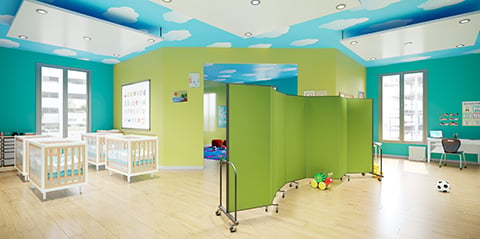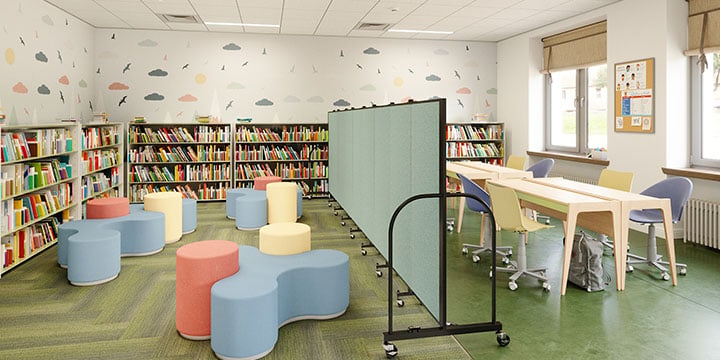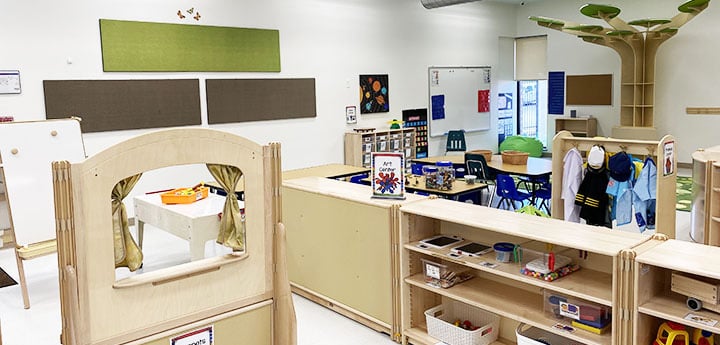Designing Your Early Childhood Classroom Environment
Market: Education
So, you’re thinking about starting an early childhood educational facility or looking for ways to revamp your existing space. Either way, there are many components to consider for any childcare facility. Early childhood educators use tried-and-true core design principles in their classroom environment to help their children grow and learn in the best way possible.
Design Elements
Colors
Before looking at the setup of your facility, some essential elements should be remembered first and foremost. First of all, children of all ages like bright colors. Brighter colors are much easier to differentiate than duller or pastel colors for learning purposes. This is why most kids’ toys, especially baby and toddler-aged ones, rarely come in neutral colors.

Colors are also instrumental in children’s capabilities in recognizing objects. For instance, basic household food items such as an apple, oranges, or bananas all have distinct and definite coloring and are among some of the first learned things. Adding colors to your space will help kids learn and feel comfortable.
Texture
Another element to consider is the implementation of different types of textures around the early childhood classroom environment. Some children’s books even include textured surfaces such as fur in the pictures of animals. By offering a variety of fuzzy, squishy, silky, rough, smooth, or any other types of textured surfaces, your kids get to experience combining multiple senses at once. Some examples of texture in your dedicated daycare space include art projects with felt, yarn, and other textiles.
Displays
In a preschool setting, utilizing multiple displays will help you and your kids. By displaying lesson reminders, you can quickly refer to them when a student has a question. The visual and audio cues combined help stimulate children’s minds. You should also have space for displaying art projects so they can show them off when parents and guardians visit.
Acoustical Support
In any room with a large number of children, it can get noisy. For this reason, having acoustical support such as wall panels or other furniture can help absorb excess sound in your space. Some acoustic wall panels not only help with auditory needs but also double as another wall display for more items. Getting them in bright colors also creates a sleek, fun look to your design.
Layout Ideas
Now that you have the essential themes, you can move on to some ideas for the general layout of your early childhood education environment. Having designated areas for each activity can help kids establish a routine and structure. Here are some necessary spaces to include.
Open Play Area
Young kids need lots of playtime for learning and enrichment. Typically, they need physical space for play times to spread out and use their imagination to create new, fun scenarios. For this reason, daycare centers will have an open play area with many buildable and interactive toys such as blocks, costumes, and other easily engageable items. By sectioning off a corner of your classroom for this type of activity, kids can play safely and without disturbing other parts of the room

Nap Area
In addition to play, children need a balance of plenty of rest. Toddlers and preschoolers, in particular, can usually take daily naps. For this reason, creating a designated nap area can help toddlers relax and settle down for their rest time. The separate space allows the kids that need rest to do it while others can read or do other quiet activities. Especially in cases where there are a lot of age groups in one classroom, the separation from nap time is imperative.
Personal Storage Area
Another physical component of the space should include a personal storage area for the kids. Many early childhood educational environments offer cubbies with hooks for their jackets. Other facilities use large bins for their kids’ storage. Regardless of how you do it, the kids will thrive from having a dedicated spot. Keeping it all tucked away in one general section reduces clutter for a tidy area.
Access to Outdoors
No matter the climate, we all need outdoor time to connect with nature and fresh air. When running an early childhood classroom, you should have an outdoor space like a blacktop, playground, or even a field that kids can access for recess. If you need more extensive outdoor areas than what is on the property, you could take your kids on nature walks in the neighborhood or take educational field trips. Getting kids to engage outdoors is a huge part of their development.
Boundaries Between Spaces
Even though an early childhood classroom environment typically resides in one room, you can still easily create sub-spaces for individual activities. Dedicating sections of the room to specific parts of your day helps add regular structure for your kids. Children, especially preschool-aged, thrive when there is an established daily routine. Offering a transition period between activities, even if going to the other end of the room, can help keep kids’ attention since they know what to expect.

Defined physical boundaries between classroom areas can help emphasize the transition time. Placing a barrier between sections of the room can help outline these boundaries. Educators have used portable room dividers, bookshelves, cubbies, and other furniture items to separate each space. Make sure that whatever barrier you use is multifunctional so you don’t cause unnecessary distracting visuals. For instance, tackable portable partitions, bookshelves, cubbies, or other furniture can help you create separation between spaces and double as displays or interactive areas.
Early childhood educators work hard and deserve all the credit they can get. By utilizing some of these ideas, they can make the most out of their space and help their children grow into the people they are meant to be.